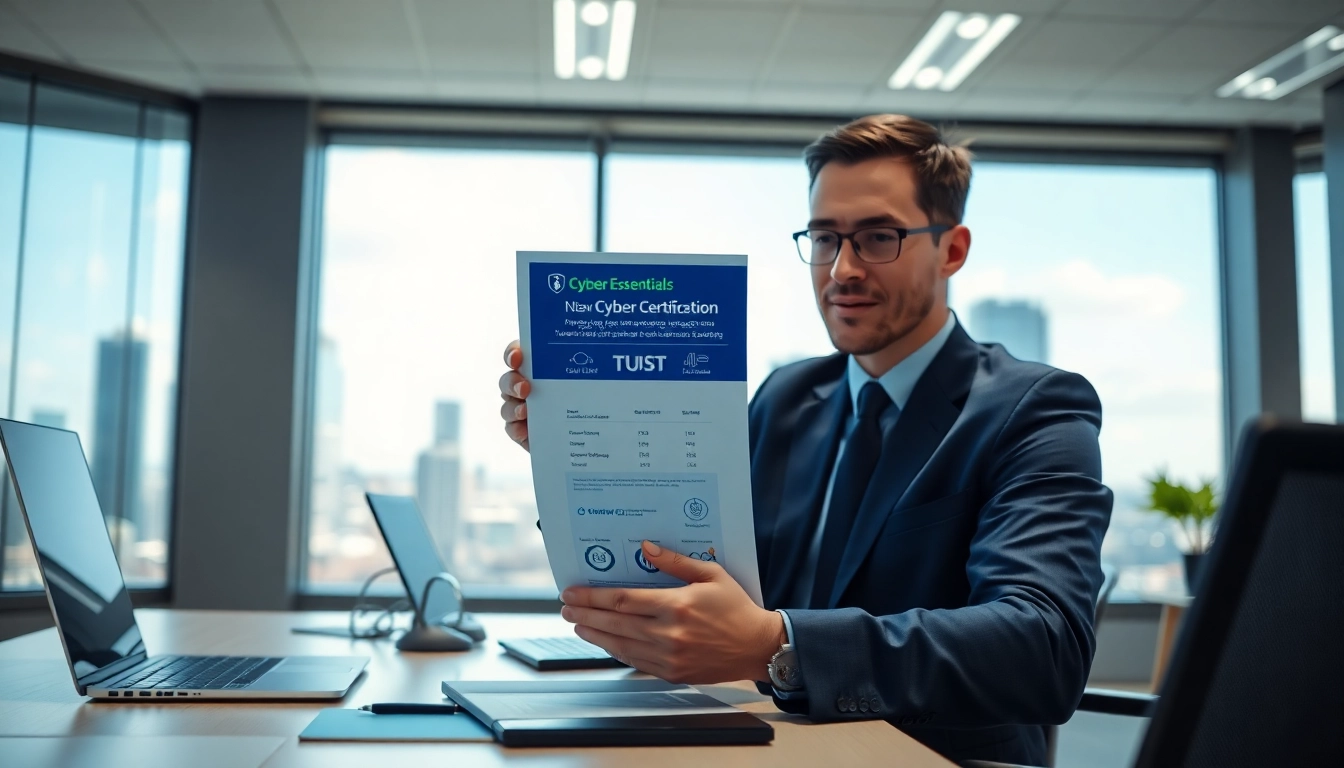Understanding Cyber Essentials Certification
In today’s digital age, the importance of ensuring robust cybersecurity measures cannot be overstated. As cyber threats evolve and become more complex, organizations are increasingly turning to certifications to validate their commitment to protecting sensitive information. One such certification is the Cyber Essentials Certification, a UK government-backed scheme designed to help businesses safeguard against common online threats. By achieving this certification, organizations can demonstrate their dedication to cybersecurity standards to clients and partners alike.
What is Cyber Essentials Certification?
Cyber Essentials Certification is a fundamental cybersecurity framework established by the UK government to provide organizations with a clear set of guidelines to protect against common cyber-attacks. This certification requires firms to implement basic security measures, ensuring that they have the foundational practices in place to fend off prevalent threats, such as phishing and ransomware.
The Cyber Essentials scheme is unique in that it not only sets a standard for cybersecurity practices but also provides a pathway for organizations to validate their compliance through formal assessment. There are two levels of certification: Cyber Essentials and Cyber Essentials Plus, the latter involving an external assessment that provides a higher level of assurance to stakeholders.
Importance of Cyber Essentials Certification for Businesses
Obtaining Cyber Essentials Certification is not merely about meeting regulatory requirements; it also offers tangible business benefits. Firstly, it boosts an organization’s credibility by demonstrating its commitment to cybersecurity. Potential clients often view a certification as a mark of reliability and professionalism, which can be a deciding factor in securing contracts.
Moreover, certification can help businesses enjoy cost savings in the long run. By implementing essential cybersecurity controls, organizations can reduce the risk of a data breach, which in turn mitigates the financial impact associated with cyber incidents, including legal fees, regulatory fines, and reputational damage.
Key Components of Cyber Essentials Certification
The Cyber Essentials framework is built around five key technical controls, which form the core of the certification process. These controls are:
- Firewalls and Internet Gateways: Properly configured firewalls act as a barrier between secure internal networks and untrusted external networks, controlling the flow of traffic and preventing unauthorized access.
- Secure Configuration: Devices and software must be securely configured to reduce vulnerabilities. This includes removing unnecessary services and ensuring software is up to date.
- User Access Control: Ensuring that users have the minimum level of access necessary to perform their jobs reduces the risk of insider threats and limiting the exposure of sensitive data.
- Malware Protection: Effective malware protection prevents, detects, and removes malicious software that could compromise the integrity of systems and data.
- Patch Management: Regularly updating and patching devices and software reduces security vulnerabilities and protects against emerging threats.
The Cyber Essentials Certification Process
Preparation for Cyber Essentials Certification
Before embarking on the Cyber Essentials Certification process, organizations should conduct a thorough internal assessment of their current cybersecurity practices. This includes reviewing existing policies and procedures as well as evaluating the technical controls against the framework’s requirements. Preparing for certification often involves the following steps:
- Conducting a risk assessment to identify and understand potential vulnerabilities.
- Engaging stakeholders across various departments to ensure a holistic approach to cybersecurity.
- Allocating necessary budget and resources to address gaps and implement required controls.
Steps to Achieve Cyber Essentials Certification
The process to achieve Cyber Essentials Certification typically involves several key steps:
- Complete the Self-Assessment Questionnaire: Organizations must fill out a self-assessment questionnaire that evaluates their compliance with the Cyber Essentials requirements.
- Submit for Assessment: Once completed, the self-assessment must be submitted to a certification body for review.
- Rectify Any Issues: If any areas of non-compliance are identified, organizations need to address these issues before certification can be granted.
- Receive Certification: Upon successful assessment, organizations will receive their Cyber Essentials Certification, signifying compliance with the standards.
Common Challenges in Certification and How to Overcome Them
While pursuing Cyber Essentials Certification, organizations often face several challenges, including:
- Lack of Awareness: Many businesses lack a full understanding of what is required to achieve certification, resulting in incomplete or inaccurate assessments.
- Resource Constraints: Smaller organizations may struggle with limited budgets and resources to implement necessary cybersecurity controls.
- Technological Complexity: Some organizations may find it daunting to navigate the technical requirements necessary for compliance.
To overcome these challenges, organizations should consider:
- Utilizing external consultants or partners who can guide them through the certification process.
- Investing in training for employees to raise awareness of cybersecurity best practices and the importance of compliance.
- Breaking down implementation steps into manageable phases to facilitate gradual compliance.
Benefits of Cyber Essentials Certification
Increasing Customer Trust through Cyber Essentials Certification
In a landscape where cyber threats are prevalent, customers prioritize security when deciding whom to trust with their data. Achieving Cyber Essentials Certification reassures clients that an organization has taken proactive steps to safeguard their information. By showcasing the certification in marketing materials and communications, organizations can enhance their brand image and effectiveness in attracting new customers.
Cost-Effectiveness of Cyber Essentials Certification
While there is an upfront investment associated with achieving Cyber Essentials Certification, the long-term cost savings can be significant. A security breach can lead to massive financial losses, including costs related to recovery, compliance fines, and reputational damage. By implementing the foundational security controls required for certification, organizations can significantly reduce their risk of breaches and associated costs.
Enhancing Security Posture with Cyber Essentials Certification
Cyber Essentials Certification is not just about achieving compliance; it also helps enhance an organization’s overall security posture. By adhering to the five key controls, organizations create a more secure environment that not only protects sensitive data but also reduces vulnerabilities. Furthermore, the process of preparing for certification encourages businesses to adopt a culture of continuous improvement and vigilance regarding cybersecurity.
Maintaining Compliance Post-Certification
Annual Review and Recertification Process
Achieving Cyber Essentials Certification is not a one-time effort; it requires ongoing maintenance and review. Organizations must undergo an annual review and reassessment to maintain their certification. This includes revisiting the self-assessment questionnaire, verifying compliance with controls, and implementing any necessary updates to procedures and technologies.
Adapting to New Cybersecurity Threats
Cyber threats are continuously evolving, and organizations must adapt their security practices accordingly. This necessitates vigilance and proactivity in monitoring for emerging threats and vulnerabilities. Organizations are encouraged to stay informed about cybersecurity trends and utilize threat intelligence to ensure that their controls remain relevant and effective.
Continuous Improvement Strategies for Cyber Essentials Certification
To ensure sustained compliance and security enhancement, organizations should focus on continuous improvement strategies, such as:
- Regular Training: Keeping security awareness at the forefront by providing ongoing employee training ensures that all staff understand their responsibilities in maintaining cybersecurity.
- Feedback Mechanisms: Establishing processes for gathering and addressing feedback on cybersecurity practices can lead to improved policies and controls.
- Regular Audits: Conducting periodic audits of compliance and security practices can identify potential weaknesses and areas for enhancement.
Resources for Cyber Essentials Certification
Guidelines and Best Practices
Organizations seeking Cyber Essentials Certification should consult various resources for guidance. The UK government provides comprehensive documentation on the Cyber Essentials framework, including detailed guidelines and best practices. Additionally, numerous industry publications and cybersecurity websites offer insightful articles and templates to aid in preparation.
Tools and Software for Supporting Compliance
Investing in tools and software solutions can facilitate compliance with Cyber Essentials requirements. Security tools such as firewalls, anti-virus software, and patch management systems can assist organizations in implementing the necessary controls. Furthermore, documentation and management solutions can streamline the certification process and ensure that compliance records are maintained effectively.
Case Studies of Successful Cyber Essentials Certification
Understanding real-world applications of Cyber Essentials Certification can offer valuable insights. Organizations across various industries have successfully leveraged the certification to enhance their security posture and build customer trust. Case studies illustrate how businesses have tackled challenges, implemented cybersecurity controls effectively, and achieved compliance with Cyber Essentials, ultimately resulting in a more secure operating environment.



